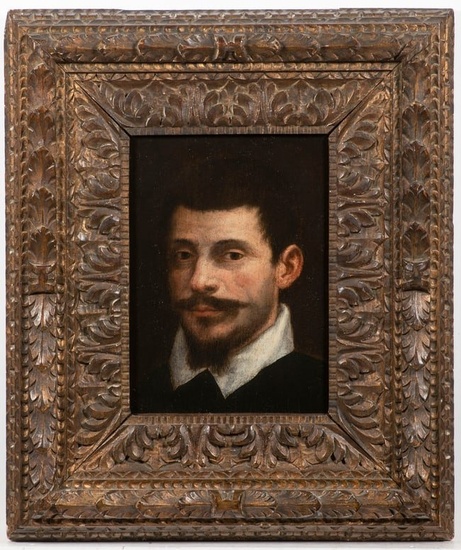Annibale Carracci (1560-1609) Portrait of a young man
The painting presents a man with thick, ebony locks, coupled with a slightly disheveled yet meticulously crafted beard in the prevailing fashion of the era, along with a broad mustache; collectively suggest the subject's early maturity, perhaps around the age of 25.Set against a backdrop of deep, neutral brown, the pure black of the robe stands out prominently, its subtle tonal variations serving as one of the most striking elements of the entire painting. Equally notable is the vibrant luminosity emanating from the subject's countenance, with rosy undertones reminiscent of the Po Valley painting, particularly evoking the style of Federico Barocci.While the composition and chromatic construction exhibit a Venetian flair, drawing inspiration from the portraiture of Lorenzo Lotto, later modernized by luminaries such as Tintoretto and Domenico, they also bear echoes of Bolognese painting traditions.In parsing the stylistic influences, one cannot overlook the interplay of Caravaggio's chiaroscuro technique, further enriching the visual narrative. Among the potential attributions, the Carracci group emerges as a compelling candidate. Notably, while Ludovico Carracci's oeuvre veered towards anti-classicism and deviated from Venetian precedents, Annibale Carracci's oeuvre, enriched by his sojourn in Venice in 1582, reflects a closer affinity to the Venetian school, particularly evident in his portraits.Annibale's works, particularly those from the turn of the century, epitomize some of the finest examples of Italian portraiture of the period. Noteworthy among them is the captivating portrayal of a young man at Palazzo Barberini, likely painted around 1590, distinguished by its nuanced handling of light and shadow. Similarities in lighting techniques and contrasts can be discerned in the painting under consideration, further bolstering the case for attribution to Carracci. Additionally, the striking resemblance to the exquisite portrayal of a child in the National Museum of Parma at the Pilotta, albeit slightly predating the present work, lends further credence to the attribution to the Carracci lineage. Oil on canvas, 36,5 × 26,5 cm
[ translate ]Estimate
Reserve
Time, Location
Auction House
The painting presents a man with thick, ebony locks, coupled with a slightly disheveled yet meticulously crafted beard in the prevailing fashion of the era, along with a broad mustache; collectively suggest the subject's early maturity, perhaps around the age of 25.Set against a backdrop of deep, neutral brown, the pure black of the robe stands out prominently, its subtle tonal variations serving as one of the most striking elements of the entire painting. Equally notable is the vibrant luminosity emanating from the subject's countenance, with rosy undertones reminiscent of the Po Valley painting, particularly evoking the style of Federico Barocci.While the composition and chromatic construction exhibit a Venetian flair, drawing inspiration from the portraiture of Lorenzo Lotto, later modernized by luminaries such as Tintoretto and Domenico, they also bear echoes of Bolognese painting traditions.In parsing the stylistic influences, one cannot overlook the interplay of Caravaggio's chiaroscuro technique, further enriching the visual narrative. Among the potential attributions, the Carracci group emerges as a compelling candidate. Notably, while Ludovico Carracci's oeuvre veered towards anti-classicism and deviated from Venetian precedents, Annibale Carracci's oeuvre, enriched by his sojourn in Venice in 1582, reflects a closer affinity to the Venetian school, particularly evident in his portraits.Annibale's works, particularly those from the turn of the century, epitomize some of the finest examples of Italian portraiture of the period. Noteworthy among them is the captivating portrayal of a young man at Palazzo Barberini, likely painted around 1590, distinguished by its nuanced handling of light and shadow. Similarities in lighting techniques and contrasts can be discerned in the painting under consideration, further bolstering the case for attribution to Carracci. Additionally, the striking resemblance to the exquisite portrayal of a child in the National Museum of Parma at the Pilotta, albeit slightly predating the present work, lends further credence to the attribution to the Carracci lineage. Oil on canvas, 36,5 × 26,5 cm
[ translate ]


